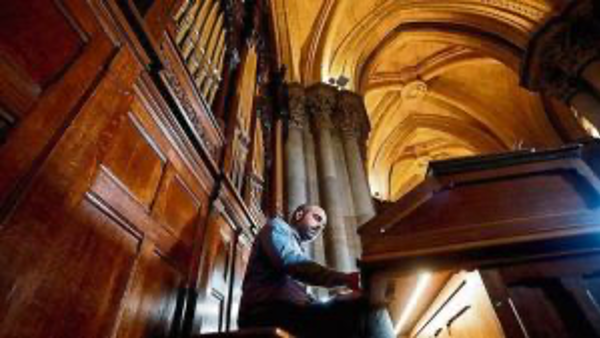Adopted from La Vanguardia, by Maricel Chavarría Barcelona and RSCJ España
Antoni Gaudí had to wait nearly a century for a musical instrument befitting the aesthetics, spirituality and artistry of the architectural space he created to be placed next to his tomb in the crypt of the Sagrada Familia.
It was 1895 when the architect completed the crypt of the basilica that would make him world famous, and which would become the most famous one in the West. The year after, the famous French organ builder (whose mother was Catalan) Aristide Cavaillé-Coll was commissioned from Barcelona to build one. Cavaillé-Coll is known as the great nineteenth-century renovator of the instrument, which he ended up turning into a grand machine with four or five keyboards operated by two human hands.
Yet few people knew that the Religious of the Sacred Heart (Congregació de les Religioses del Sagrat Cor) had this Cavaillé-Coll organ in its church on Diputació Street in Barcelona, right where there was a factory that Gaudí had worked in. When they decided to donate it to the Sagrada Família in 2019, the organist of the basilica, Juan de la Rubia, nearly fainted, aware that it was the equivalent of a Stradivarius.
"Opening the lid and seeing the Cavaillé-Coll inscription is a luxury for an organist, it signifies a certain sound, certain technical characteristics...like those of the organ of Saint Sulplice or of Notre-Dame de Paris," he points out. "In terms of heritage, the organs have enormous value, as we saw with the fire in the Parisian cathedral. In Spain, there are more examples of Cavaillé-Coll in churches in the Basque Country, which also preserve the originals. But this is the only one that exists in Catalonia".
The instrument was very lucky when, during the outbreak of the civil war, it survived the looting and destruction of the convent’s furniture. That is, except for the pipes, whose metal was highly sought after for armaments. Since its reconstruction, it had not undergone any other overhaul, and so a year and a half ago the Sagrada Familia started a fundraising campaign, "Sponsor a Pipe", to restore it.
The organ builder, Albert Blancafort, undertook the work in the Blancafort Orgueners workshop in Montserrat, using the finest materials: an oak wood case, tin pipes and brass mechanical elements. The restoration has involved four thousand hours of work, dismantling and restoring each of its parts. “Each organ is made to measure, a work of art like a sculpture or a good painting," he says, "and it is not static because the organist brings out its sound".
Now that it has finally been installed in the crypt’s chapel, where there had been another before the war, it has become clear that the neo-Gothic organ fits perfectly with the contemporary architecture of the crypt, not only in terms of its size (5.4 meters high by 3.1 meters wide and 3 meters deep) but for its aesthetics and sound, says Mossèn Josep Maria Turull, rector of the basilica and the parish of the Sagrada Família. "It ended up here by providence, so that people from all over the world can enjoy it". Yesterday Bishop Sergi Gordo presided over its solemn blessing.
Regarding its sound, it should be noted that registers have been added at the back, so that it now has thirteen, with 639 tubes distributed over two keyboards and a pedal. Juan de la Rubia speaks of a beautifully romantic, round, full-bodied sonority. "A perfect sound for liturgical accompaniment and for concerts".
In this sense, the basilica plans to use it three ways: liturgically, culturally (with solo concerts or accompanied by chamber ensembles) and pedagogically, as it will be made available to students of the ESMUC (Escola Superior de Música de Catalunya). "This instrument is a second teacher, it guides you, takes you and teaches you," explains De la Rubia.
"It is a new rebirth of this organ for the city and for the world," concluded Mossen Turull, who indicated that for the moment the donations have only covered half of the 178,000 Euro budget for the restoration - "an investment for the future" – and so the campaign continues.
Gaudí’s genius now has at its side the work of another genius - what better tribute to the architect?

